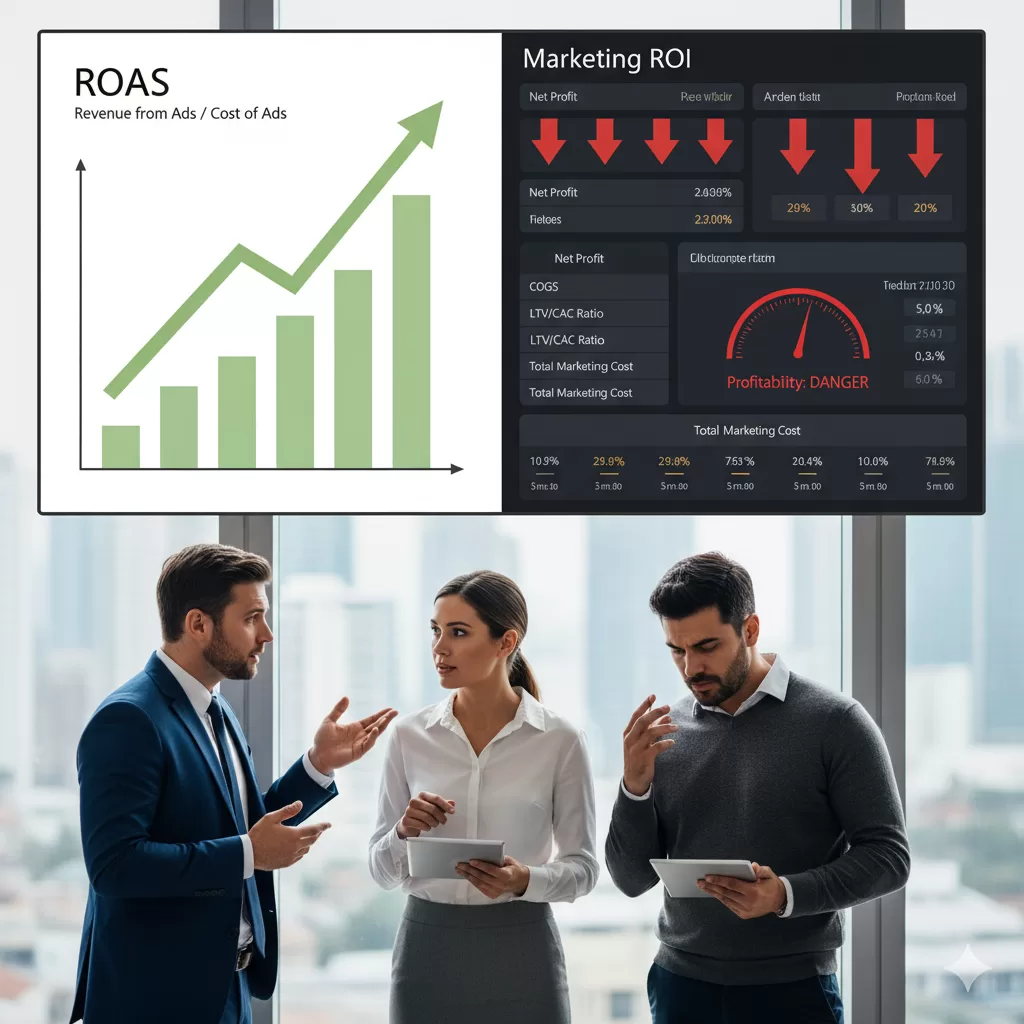Table of Contents
ROAS vs ROI: Why your business should care?
For years, Return on Ad Spend (ROAS) has been the dominant metric for evaluating digital advertising success. It is simple, accessible, and provides a quick measure of campaign efficiency. However, this simplicity is deceptive. ROAS is a vanity metric that offers a dangerously incomplete picture of performance, often masking critical issues like poor profit margins and unsustainable growth strategies. While 63.3% of marketers feel pressure from their CFO to prove the value of marketing, relying on ROAS alone fails to speak the language of business outcomes: profitability. This article argues for a strategic shift away from the tactical comfort of ROAS towards a more robust, profit-focused framework, leveraging Return on Investment (ROI) and a holistic data approach. For CMOs and CEOs, moving beyond ROAS is not just an analytical upgrade; it is a fundamental change in mindset required to drive genuine, sustainable growth.
ROAS vs ROI : The Dangerous Allure of ROAS: Why We Can’t Look Away
Return on Ad Spend, calculated as ROAS = Cost of Ads Revenue from Ads, has become the default KPI in digital advertising for understandable reasons. It is readily available in every advertising platform, from Google to Meta, providing an immediate, digestible snapshot of performance. This accessibility makes it a convenient tool for campaign managers to make real-time budget decisions and for agencies to report on tactical efficiency.
However, this convenience comes at a high cost. The relentless focus on ROAS creates several systemic problems:
- It prioritises revenue over profit. A campaign with a 10x ROAS looks impressive on a dashboard, but if it promotes low-margin products, the actual profit could be minimal or even negative.
- It fosters short-term thinking. Optimising for ROAS often means focusing on bottom-of-the-funnel tactics like remarketing or branded search terms, which capture customers who were likely to convert anyway, rather than investing in acquiring new, high-value customers.
- It operates in a silo. ROAS ignores the complex, omnichannel journey of a modern customer, failing to account for the influence of other touchpoints like organic search, email marketing, or brand-building activities that contribute to the final sale.
This narrow focus has lulled many marketers into a false sense of security, mistaking tactical efficiency for strategic success.
ROAS vs ROI : Why ROAS Alone Fails Your Business Outcomes
Relying on ROAS as a primary measure of success is like steering a ship using only a compass; it tells you a direction but reveals nothing about the currents, the depth of the water, or the fuel in your tank. The fundamental flaw is that ROAS is completely disconnected from profitability.
Consider this scenario:
- Campaign A sells a high-volume, low-margin product. It spends 1000 € on ads and generates 5000 € in revenue. ROAS = 5x.
- Campaign B sells a lower-volume, high-margin product. It also spends 1000 € and generates 5000€ in revenue. ROAS = 5x.
On the surface, both campaigns are equally successful. But if the cost of goods sold (COGS) for Campaign A is 4500 €, the profit is a mere 500 €. If the COGS for Campaign B is 1500€, the profit is 3500 €. Same ROAS, but a 7x difference in profit. This is the central failing of ROAS: it measures the efficiency of generating revenue, not the effectiveness of creating business value.
Furthermore, ROAS overlooks long-term value. A campaign might have a modest initial ROAS but acquire customers with a high lifetime value (LTV) who make repeat purchases for years. Conversely, a campaign with a spectacular ROAS might attract one-time discount shoppers who never return. Without factoring in LTV, you are undervaluing your most crucial marketing efforts.
ROAS vs ROI : The Strategic Alternative: Embracing ROI and a Data-Driven Framework
To align marketing with true business objectives, leaders must shift the conversation from revenue efficiency to overall profitability. This requires moving from ROAS to a more comprehensive metric: Return on Investment (ROI).
The formula for Marketing ROI is (Profit from campaign – Marketing Cost)/ Marketing Costs ×100
Example:
If a small marketing campaign generated €10,000 in revenue, and the profit margin was 20%, that’s €2000 in profit. If the campaign’s total cost was €500, then:
- Generated Profit from Marketing campaign: €2,000
- Marketing Costs: €500
- ROMI Calculation: (€2000 – €500) / €500 × 100 = 300%
Unlike ROAS, ROI accounts for all costs associated with a marketing effort, including ad spend, agency fees, software subscriptions, and even marketing salaries, measuring it against the net profit generated. It answers the fundamental question the C-suite is asking: “For every Euro we invest in marketing, how much profit are we getting back?”.
Calculating true ROI is more complex and requires a mature data infrastructure, a challenge that can be addressed by adopting a structured methodology like the IDIRA Marketing framework.
- Integration of Data: This is the foundational step. To calculate profit, you must break down data silos. This means integrating data from ad platforms (e.g., Google Ads), web analytics (Google Analytics 4), your Customer Relationship Management (CRM) system, and your Enterprise Resource Planning (ERP) system to get a full view of revenue and costs.
- Data Collection: Ensure accurate and reliable data is collected across all touchpoints. This involves robust tracking setups and a clear understanding of data governance.
- Insights: With integrated data, you can move beyond surface-level metrics. You can calculate KPIs that truly matter for business outcomes, such as Profit on Ad Spend (POAS), Customer Acquisition Cost (CAC), and Customer Lifetime Value (LTV).
- Reports: Build dashboards that communicate these business-centric KPIs to leadership. Visualise profit trends, not just revenue spikes. This elevates the marketing function from a cost centre to a documented growth driver.
- Artificial Intelligence: Leverage AI and machine learning to analyse complex datasets and provide predictive insights. Advanced models from firms like Google (Gemini), OpenAI, Anthropic (Claude), and Mistral can help in marketing mix modelling to understand the true contribution of each channel and forecast the LTV of different customer segments, providing a far more sophisticated view than simple ROAS allows.
ROAS vs ROI: Actions for Executive Leadership
Continuing to optimise for ROAS is a recipe for busy, but ultimately unprofitable, marketing. It encourages chasing revenue at the expense of margin and short-term wins at the expense of long-term customer relationships. For marketing to be seen as a core driver of business growth, its performance must be measured in the language of the boardroom: profit and ROI.
CMOs and CEOs must lead this change. Here are the crucial first steps:
- Mandate a Shift in Measurement: Redefine “success” internally. Move incentive structures and reporting away from ROAS and towards profit-centric metrics, such as POAS, and ultimately, true marketing ROI.
- Invest in Your Data Infrastructure: You cannot measure what you cannot see. Prioritise projects that integrate your sales, marketing, and financial data to create a foundational data structure. A partner like IT Tech BuZ can be instrumental in this regard.
- Educate Your Teams and Agencies: Ensure that everyone involved in marketing, from internal teams to external partners, understands why the focus is shifting. Align their goals with profitability, not just ad spend efficiency (align costs of sales and margin)
- Start Now, Perfect Later: The journey from ROAS to ROI can be complex. Begin by calculating POAS (POAS=Ad Spend(Revenue–COGS)), which is often a more accessible first step. This alone will provide a much clearer picture of campaign profitability and set the stage for a full ROI implementation.
The transition requires investment and a cultural shift, but the reward is a marketing engine that is directly and demonstrably tied to the financial health and sustainable growth of the business.
Frequently Asked Questions (FAQs)
- Is ROAS ever a useful metric? Yes, ROAS can be a helpful diagnostic tool for media buyers to quickly compare the revenue efficiency of different ad campaigns or channels. However, it should never be the primary or sole metric used to judge overall marketing success. It is a tactical indicator, not a strategic one.
- What is the difference between ROAS and POAS (Profit on Ad Spend)? ROAS measures the gross revenue generated for every dollar of ad spend. POAS is a more advanced metric that measures the gross profit (Revenue – Cost of Goods Sold) for every dollar of ad spend. POAS is a significant step up from ROAS because it factors in product margins, giving a clearer view of profitability.
- How can I start calculating ROI if my data is siloed? Start by manually integrating data for a single campaign. Export your ad spend data, your sales revenue from your e-commerce platform or CRM, and your cost of goods sold from your financial records. Use a spreadsheet to calculate ROI for that specific initiative. This process will highlight the data integration challenges you need to solve to scale the calculation. Services that focus on Data Integration are crucial for this.
- Why do so many advertisers and agencies still focus on ROAS? Advertisers persist with ROAS due to its simplicity, its universal availability in ad platforms, and institutional inertia. For agencies, it is often an easier metric to influence and report on than a complex metric like ROI, which requires access to the client’s sensitive financial data.
- How does Customer Lifetime Value (LTV) fit into measuring marketing success? LTV is a critical component of a sophisticated marketing measurement framework. A campaign might have a low initial ROI or ROAS, but acquire customers who generate significant profit over many years. Comparing the LTV to the Customer Acquisition Cost (CAC) provides a powerful indicator of long-term, sustainable profitability, moving far beyond the limitations of single-campaign metrics.
References (APA 7th Edition):
- AgencyAnalytics. (2025, March 18). ROI vs. ROAS: How to explain the difference to clients. Retrieved from https://agencyanalytics.com/blog/roas-vs-roi
- Andava. (2024, January 14). Calculating marketing ROI vs ROAS: What’s the difference? Retrieved from https://www.andava.com/learn/roi-vs-roas/
- GroundTruth. (2024, March 19). Companies should use ROAS to scale audiences and real business results. Retrieved from https://www.groundtruth.com/insight/use-roas-to-scale-audiences-and-real-business-results/
- JENTIS. (2025, September 12). POAS vs. ROAS. Retrieved from https://www.jentis.com/blog/poas-vs-roas
- LinkedIn Business. (n.d.). Boost ROAS: Strategies & insights. Retrieved from https://business.linkedin.com/marketing-solutions/success/marketing-terms/roas
- McKinsey & Company. (n.d.). Marketing performance: How marketers drive profitable growth. Retrieved from https://www.mckinsey.com/capabilities/growth-marketing-and-sales/our-insights/marketing-performance
- Push Group. (2025, May 20). Why ROAS alone won’t grow your business. Retrieved from https://www.pushgroup.co.uk/blog/why-roas-alone-wont-grow-your-business





